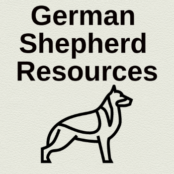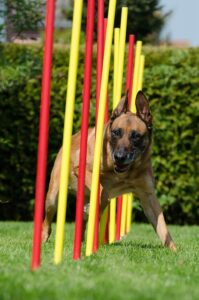If you’re a German Shepherd owner, you probably marvel daily at your canine companion’s strength, intelligence, and agility. German Shepherds are a beloved breed, known for their loyalty, sharp minds, and ability to learn and follow commands. But did you know that these versatile dogs can excel in agility training too? Learn more about German shepherd agility training.
Agility training is not just for professional dog competitions; it’s a fantastic way to build an even stronger bond with your German Shepherd, keep them active and healthy, and satisfy their natural instincts for work and purpose.
In this comprehensive guide, tailored specifically for first-time agility trainers, we will walk you through all the essential tips and strategies to start your German Shepherd on a successful agility training journey. From the first steps of preparation to conquering the agility course, we’ve got you covered.
Table of Contents
Introduction to Agility Training
Before lacing up your training shoes, it’s important to understand what agility training entails. Agility is a sport where dogs move through an obstacle course with the guidance of their handler. The idea is to test and demonstrate the dog’s agility, accuracy, and speed.
Understanding the Concept of Agility Training for Dogs
Agility training is a form of physical and mental exercise that requires your dog to spring, weave, tunnel, and scale a variety of obstacles. It’s a full-body workout that sharpens your dog’s coordination and fine-tunes their ability to follow your commands instantly.
Benefits of Agility Training for German Shepherds
For high-energy breeds like German Shepherds, agility training is a perfect outlet. It not only serves as an excellent way to burn off excess energy but also enhances their overall health, including cardiovascular fitness and muscle strength. Mentally, agility training challenges their problem-solving skills and helps in building confidence.
Finding a Mentor or Training Club
An essential step in your agility training journey is finding an experienced mentor or joining a training club. This can significantly accelerate your German Shepherd’s learning curve. Look for trainers or clubs that have a solid track record with high-energy breeds and that understand the unique characteristics of German Shepherds. A good mentor will not only teach your dog the agility basics but will also provide you with personalized advice to enhance your handling skills. Training clubs offer the added benefit of socializing your dog with others, which is crucial for their behavioral development. You can start your search by checking local dog training centers, asking for recommendations from fellow dog owners, or searching online for agility training groups in your area. Be careful. Not all trainers or clubs are equal.
Crazy Dog People
Keep in mind some people take winning very seriously. They may be super competitive or even down right unhelpful to new comers. That’s not generally the case in agility but I have been told by more than one person it is often the case in confirmation. I have only had experience with NASDA. If you dog has an issue with reactivity like Jasper does, you may want to work through that with a trainer before trying to compete. I was lucky in that the breeder I got Jasper from was a judge in NASDA and I have been able to compete some as she is willing to accommodate his reactivity when possible by having the other handlers put their dogs up before he runs his trial. In other trial that were not hers they were not willing to do that and considered it a “training issue,” another words my problem. To be fair if it is a large trial it would likely not be possible for my breeder either. They do run one dog at a time in most these sports but it’s the getting to and from the starting line that can be an issue. Also spectators with their dogs could be an issue if your dog is reactive. Don’t get discouraged as reactivity can be worked through.
Preparation for Agility Training
A successful agility training program begins with meticulous preparation. This stage not only ensures your dog is ready but also sets you up for a smooth training experience.
Assessing Your German Shepherd’s Health and Fitness Level
Agility training can be intense. Before starting, it’s crucial to get a clean bill of health from your veterinarian. Also, assess if your German Shepherd is at an ideal weight and fitness level. Overweight or under-conditioned dogs could strain themselves during training.
Basic Obedience Skills Necessary Before Starting Agility Training
Agility requires your dog to obey commands instantly. Therefore, a solid foundation of basic commands like sit, stay, come, and heel is non-negotiable. If your dog is not proficient in these, sign up for an obedience class.
Gathering the Right Equipment for Training
Before you start, collect the essential gear. This includes training treats, a harness or collar, a leash, and, most importantly, agility-specific equipment such as jumps, weave poles, and tunnels.
Starting with the Basics
When it’s time to start training, take it one step at a time. Here’s how to set the stage for a solid agility foundation.
Introducing Your German Shepherd to Agility Equipment
For a dog unaccustomed to this strange new equipment, it can be daunting. Begin with simple pieces, letting your dog explore them at their own pace, without any pressure.
Developing a Training Schedule That Works for Both You and Your Dog
Consistency is key in dog training. Create a training schedule that fits into your routine, and avoid long, exhausting training sessions. Short bursts of training, say 10-15 minutes a few times a week, is far more effective.
Importance of Patience and Positive Reinforcement
Agility training is a partnership, and it’s one that requires a lot of patience. Always use positive reinforcement. Celebrate even the smallest successes during training, and your dog will learn to enjoy the process.
Core Agility Exercises for Beginners
Transform your dog into an agile athlete with these fundamental exercises.
Teaching Your Dog to Jump Over Hurdles
The ‘jump’ is the first agility obstacle most dogs learn. Start with a low bar, and gradually raise it as your dog’s confidence grows. Use your dog’s favorite toy or treat to motivate them.
Navigating Through Weave Poles
Weaving through the poles is a bit more complex. Begin with just a couple of poles, spaced widely apart. As your dog becomes comfortable, decrease the space between the poles and increase their number.
Tunnel Training Basics
The tunnel is a favorite for many dogs. Start with a short and straight tunnel — even a child’s play tunnel will suffice. Encourage your dog to walk through with a lure and gradually phase the lure out.
Learning the A-Frame and Seesaw
These are often the last to be taught. Your dog must be confident and adept with basic jumps and tunnels first. Start with a low, safe A-Frame or Seesaw, and slowly work up to a full-size option.
Building on Success
Once your dog has the hang of the basic obstacles, it’s time to step up the challenge.
Increasing Complexity Gradually
With each training session, slightly raise the bar – literally and figuratively. Add more distance, increase the height, or decrease the width of obstacles. Keep progress incremental. If your dog seems confused go back to an earlier training session he did competently and start again from there.
Combining Obstacles for Course Runs
Agility is about the mix. Combine several obstacles into a small course and teach your dog to sequence through them. Use the same sequence repeatedly until your dog is moving through it confidently.
Tips for Improving Speed and Accuracy
Maintain consistency in training and communicate clearly with your dog. Be mindful of your body cues, and remember, the more practice, the better.
Maintaining Motivation and Enjoyment
Your German Shepherd should look forward to agility training. Keep it fun and engaging.
Keeping Training Sessions Fun and Engaging
Incorporate games into your training sessions. Play tug-of-war or hide and seek with their favorite toy. 10 to 15 minutes is plenty. Better yet 5 minutes twice a day. A training session that feels like a game will be far more effective and enjoyable.
Recognizing and Rewarding Progress
Offer plenty of positive reinforcement during training. Verbal praise, treats, and play time are all great ways to celebrate your dog’s progress.
Adjusting Training as Your German Shepherd Advances
Customize the training to your dog’s pace and preference. If your dog seems particularly skilled at one obstacle, you might spend more time on that, instead of sticking strictly to your original plan.
Common Challenges and Solutions
Obstacles are natural in the training process. Here’s how to overcome them.
Addressing Fear or Hesitation with Certain Obstacles
If your dog seems hesitant, pause and regroup. Never force your dog to complete an obstacle. Go back a step and rebuild their confidence with rewards and reassurance.
Dealing with Training Plateaus
Your dog might reach a point where progress slows. This is normal. Take a break if necessary, revisit basic skills, or try a new approach. Sometimes, a break will result in a surprise leap in progress.
Solutions for Common Behavioral Issues During Agility Training
From jumping the gun to losing focus, there can be behavioral hiccups. Revisit your training schedule, include more play, and mix up the rewards to re-engage your dog’s attention.
Competing in Agility Trials
For many enthusiasts, the ultimate goal is to compete in agility trials. Here’s how to get ready.
Preparing for Your First Agility Trial
Find out what’s involved in the trial. Acquaint your dog with the environment and practice course runs that mimic the requirements of the trial. You have to pay a fee to trial your dog and fill out a form entering the trial. You are given a time slot and must be there ready to go at the appointed time.
What to Expect on the Day of the Competition
Be prepared with all the necessary documentation and equipment. On the day, keep your energy positive, calm, and collected.
Tips for a Successful Agility Competition Experience
Listen to the advice of experienced handlers. Stay focused on your dog, and never get discouraged by setbacks. Competitions are as much a learning experience for you as they are for your dog.
Continued Learning and Training
Agility is a dynamic sport, and learning should never stop.
Sources for Advanced Training Tips and Techniques
There are countless books, videos, and courses on advanced agility training techniques. Continuing to educate yourself is crucial for advancing in the sport.
Joining Agility Clubs and Communities for Support and Advice
The agility community is a rich source of support and knowledge. Join an agility club or participate in online forums to connect with like-minded trainers.
Setting New Training Goals for You and Your German Shepherd
Once you’ve mastered the basics, set new goals for you and your dog: faster times, more complex courses, and even more advanced tricks. Agility training is a lifelong journey, and the possibilities are endless.
With dedication, patience, and the right training, your German Shepherd will be gracefully gliding through tunnels and weaving through poles before you know it. Join the growing community of agility enthusiasts, and experience the transformation that agility training can bring to you and your beloved pet.
Now, march on to the training ground, and craft not just an agile, but a profoundly connected partnership with your German Shepherd through agility training. The leaps and bounds of your dog will echo with your shared triumphs and the joy of a well-spent bond.


